Marfan syndrome
Marfan syndrome
overview
Marfan syndrome is an inherited disorder that affects connective tissue - the fibers that support and anchor your organs and other structures in your body. Marfan syndrome most commonly affects the heart, eyes, blood vessels, and skeleton.
People with Marfan syndrome are usually tall and thin with unusually long arms, legs, fingers and toes. The damage caused by Marfan syndrome can be mild or severe. If your aorta — the large blood vessel that carries blood from your heart to the rest of your body — is affected, the condition can become life-threatening.
Treatment usually includes medication to keep your blood pressure low and reduce stress on your aorta. Regular monitoring to check the progress of the damage is essential. Many people with Marfan syndrome eventually need preventive surgery to repair the aorta.
Symptoms
Finger length in Marfan syndrome
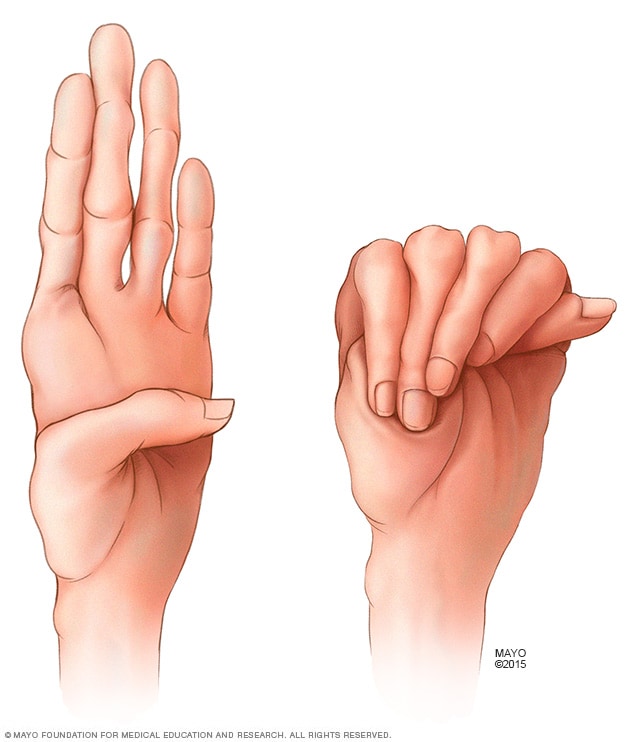
Finger length in Marfan syndrome
People with Marfan syndrome typically have particularly long fingers. It is common for their thumbs to extend well past the edge of their hand when they make a fist.
Longer arms in Marfan syndrome
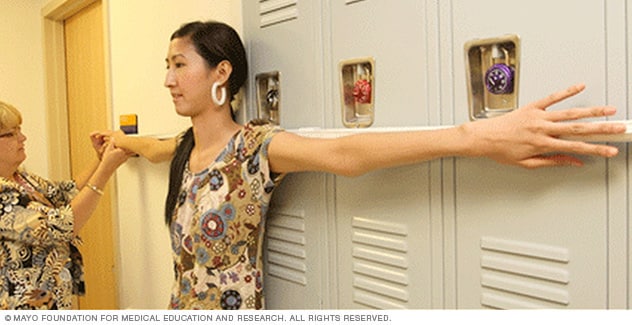
Longer arms in Marfan syndrome
Marfan syndrome is a genetic disorder that causes people to have unusually long arms, legs and fingers. Your doctor may want to measure your arm span if he or she thinks you may have the disorder.
The signs and symptoms of Marfan syndrome can vary widely even among members of the same family because the condition can affect so many different areas of the body. Some people experience only mild effects, while others develop life-threatening complications.
Features of Marfan syndrome may include:
- Groß und schlank gebaut
- Überproportional lange Arme, Beine und Finger
- Ein Brustbein, das nach außen ragt oder nach innen einfällt
- Ein hoher, gewölbter Gaumen und überfüllte Zähne
- Herzgeräusche
- Extreme Kurzsichtigkeit
- Eine ungewöhnlich gekrümmte Wirbelsäule
- Flache Füße
When to go to the doctor?
If you think you or your child may have Marfan syndrome, talk to your doctor or pediatrician. If your doctor suspects a problem, you will likely be referred to a specialist for further evaluation.
Causes
Marfan syndrome is caused by a defect in the gene that allows your body to produce a protein that gives connective tissue its elasticity and strength.
Most people with Marfan syndrome inherit the abnormal gene from a parent who has the disorder. Each child of an affected parent has a 50:50 chance of inheriting the defective gene. In about 25% of people with Marfan syndrome, the abnormal gene does not come from either parent. In these cases, a new mutation develops spontaneously.
Risk factors
Marfan syndrome affects men and women equally and occurs in all racial and ethnic groups. Because it is a genetic condition, the biggest risk factor for Marfan syndrome is having a parent with the condition.
Complications
Aneurysm at the aortic root

Aneurysm at the aortic root
The pressure of the blood leaving your heart can cause the wall of your aorta to bulge, like a weak spot in a tire. In people with Marfan syndrome, this is most likely to occur at the aortic root - where the artery leaves your heart.
Aortic aneurysm and aortic dissection
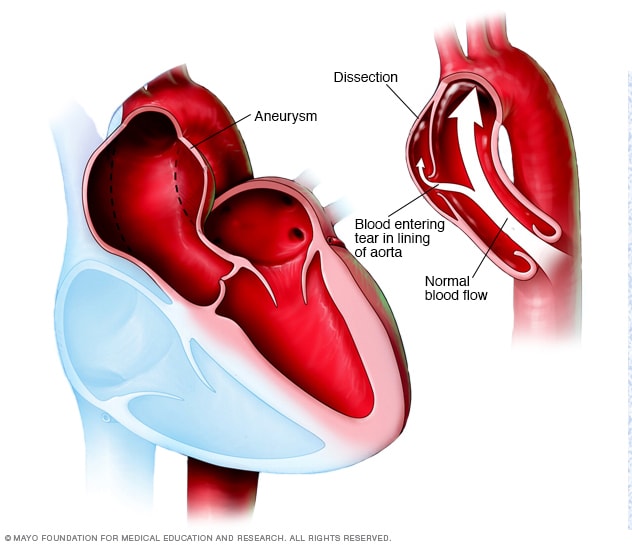
Aortic aneurysm and aortic dissection
An aortic aneurysm occurs when a weak spot in the wall of your aorta begins to bulge (left). This can occur anywhere in your aorta. Having an aneurysm increases the risk of aortic dissection – a tear in the lining of the aorta, as shown in the image to the right.
Lens dislocation
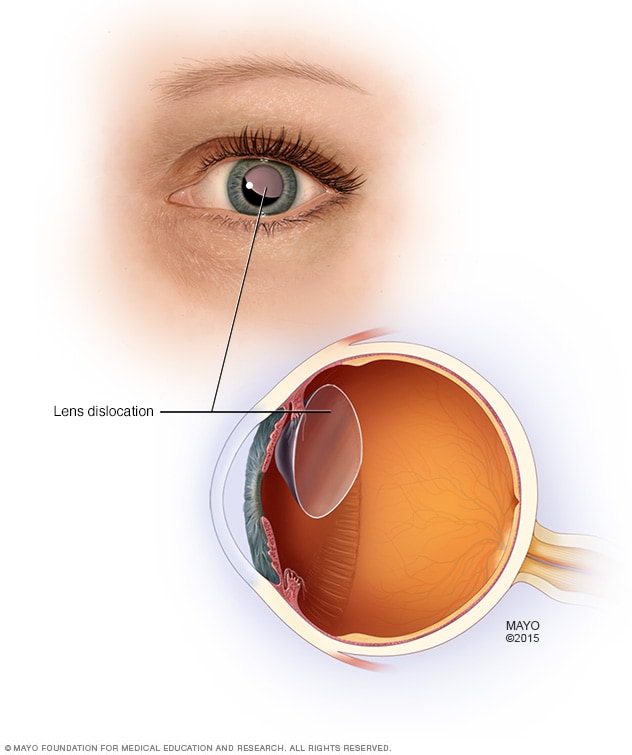
Lens dislocation
Some people with Marfan syndrome may experience dislocation of the lens in their eye.
Retinal detachment
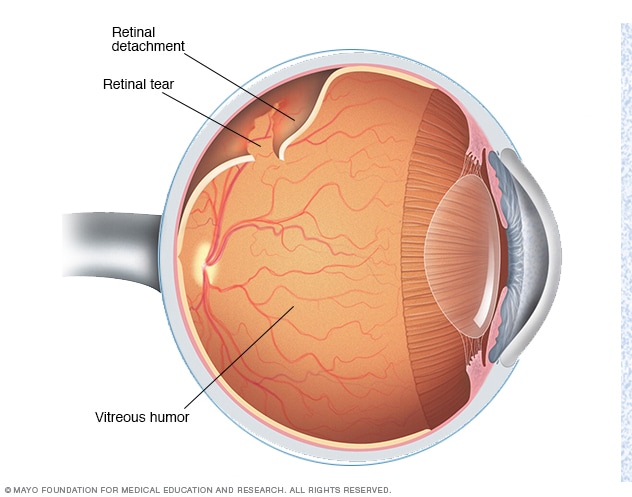
Retinal detachment
Retinal detachment describes an emergency situation in which a critical layer of tissue (the retina) at the back of the eye separates from the layer of blood vessels that supply it with oxygen and nutrients. A retinal detachment is often accompanied by flashes and floaters in your vision.
Scoliosis
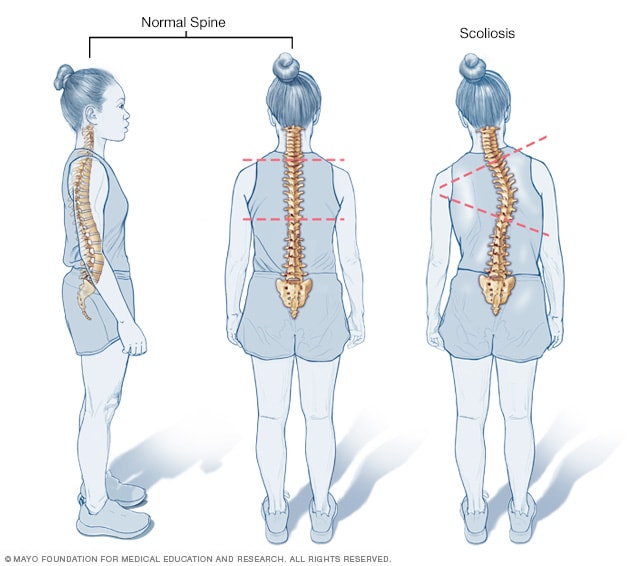
Scoliosis
When viewed from the side, the normal spine is shaped like an elongated S, with the upper back curving outward and the lower back curving slightly inward. However, when viewed from behind, the spine should appear as a straight line from the base of the neck to the tailbone. Scoliosis is a lateral curvature of the spine.
Breast abnormalities

Breast abnormalities
Marfan syndrome can affect the normal development of the ribs, which can cause the sternum to either protrude or appear sunken into the chest.
Because Marfan syndrome can affect almost any part of your body, it can cause a variety of complications.
Cardiovascular complications
The most dangerous complications of Marfan syndrome affect the heart and blood vessels. Faulty connective tissue can weaken the aorta - the large artery that originates from the heart and supplies blood to the body.
- Aortenaneurysma. Der Druck des Blutes, das Ihr Herz verlässt, kann dazu führen, dass sich die Wand Ihrer Aorta ausbeult, wie eine schwache Stelle in einem Reifen. Bei Menschen mit Marfan-Syndrom tritt dies am ehesten an der Aortenwurzel auf – dort, wo die Arterie Ihr Herz verlässt.
- Aortendissektion. Die Wand der Aorta besteht aus Schichten. Eine Dissektion tritt auf, wenn ein kleiner Riss in der innersten Schicht der Wand der Aorta Blut zwischen der inneren und der äußeren Schicht der Wand quetschen lässt. Dies kann zu starken Schmerzen in der Brust oder im Rücken führen. Eine Aortendissektion schwächt die Gefäßstruktur und kann zu einem Riss führen, der tödlich sein kann.
- Ventilfehlbildungen. Menschen mit Marfan-Syndrom können schwaches Gewebe in ihren Herzklappen haben. Dies kann zu einer Dehnung des Klappengewebes und einer abnormalen Klappenfunktion führen. Wenn Herzklappen nicht richtig funktionieren, muss Ihr Herz oft härter arbeiten, um dies auszugleichen. Dies kann schließlich zu Herzversagen führen.
Eye complications
Eye complications can include:
- Linsendislokation. Die Fokussierlinse in Ihrem Auge kann sich verschieben, wenn ihre Stützstrukturen schwächer werden. Der medizinische Fachausdruck für dieses Problem ist Ectopie lentis, und es tritt bei mehr als der Hälfte der Menschen mit dem Marfan-Syndrom auf.
- Netzhautprobleme. Das Marfan-Syndrom erhöht auch das Risiko einer Ablösung oder eines Risses in der Netzhaut, dem lichtempfindlichen Gewebe, das die Rückwand Ihres Auges auskleidet.
- Früh einsetzendes Glaukom oder Katarakte. Menschen mit Marfan-Syndrom neigen dazu, diese Augenprobleme in einem jüngeren Alter zu entwickeln. Beim Glaukom steigt der Augeninnendruck an, was den Sehnerv schädigen kann. Katarakte sind trübe Bereiche in der normalerweise klaren Linse des Auges.
Skeletal complications
Marfan syndrome increases the risk of abnormal curvatures of the spine, such as: B. Scoliosis. It can also interfere with the normal development of the ribs, which can cause the sternum to either protrude or appear sunken into the chest. Foot pain and back pain are common in Marfan syndrome.
Complications of pregnancy
Marfan syndrome can weaken the walls of the aorta, the main artery that leaves the heart. During pregnancy, the heart pumps more blood than usual. This can place additional stress on the aorta, increasing the risk of fatal dissection or rupture.
Treatment of Marfan syndrome
Sources:
- Marfan-Syndrom: Ausführlich. National Institute of Arthritis and Musculoskeletal and Skin Diseases. https://www.niams.nih.gov/health-topics/marfan-syndrome/advanced. Abgerufen am 28. Januar 2021.
- Ferri FF. Marfan-Syndrom. In: Ferri’s Clinical Advisor 2021. Elsevier; 2021. https://www.clinicalkey.com. Abgerufen am 28. Januar 2021.
- Kliegman RM, et al. Marfan-Syndrom. In: Nelson Lehrbuch der Kinderheilkunde. 21. Aufl. Elsevier; 2020. https://www.clinicalkey.com. Abgerufen am 28. Januar 2021.
- Wright MJ, et al. Genetik, klinische Merkmale und Diagnose des Marfan-Syndroms und verwandter Erkrankungen. https://www.uptodate.com/contents/search. Abgerufen am 28. Januar 2021.
- Wright MJ, et al. Management des Marfan-Syndroms und verwandter Erkrankungen. https://www.uptodate.com/contents/search. Abgerufen am 28. Januar 2021.
- Fragen Sie MayoExpert. Marfan-Syndrom. Mayo-Klinik; 2020.
- Ihr Teenager und Marfan oder eine verwandte Störung. Die Marfan-Stiftung. https://www.marfan.org/event/parent-toolkit/your-teen-marfan-related-disorder. Abgerufen am 3. Februar 2021.
- Die Schule Ihres Kindes. Die Marfan-Stiftung. https://www.marfan.org/event/parent-toolkit/your-childs-school. Abgerufen am 3. Februar 2021.
- Büro für Patientenaufklärung. Marfan-Syndrom. Mayo-Klinik; 2018.
- Bowen J (Gutachten). Mayo-Klinik. 2. März 2021.
- Morrow ES Jr. Allscripts EPSi. Mayo-Klinik. 16. Februar 2021.

 Suche
Suche
 Mein Konto
Mein Konto